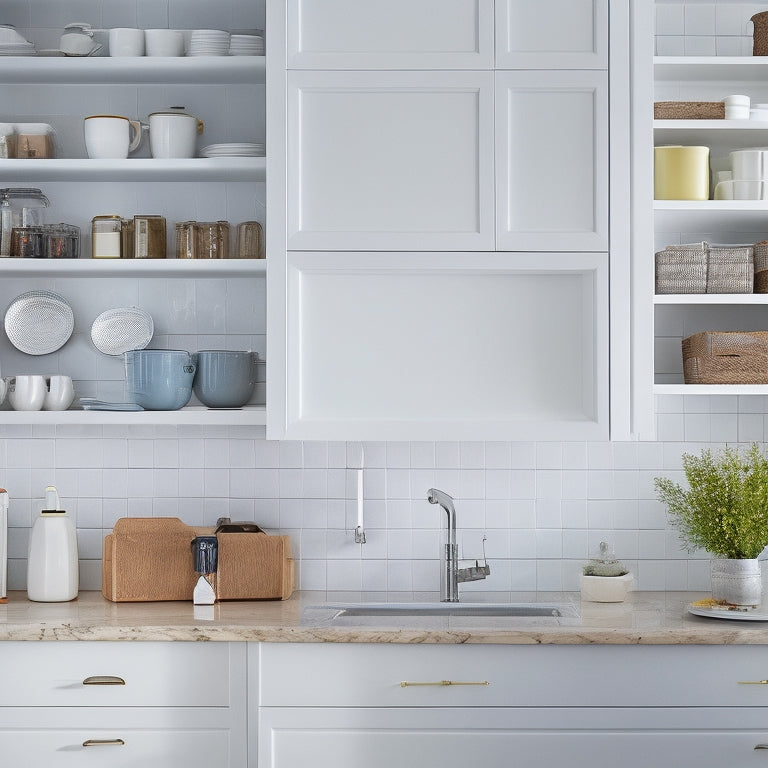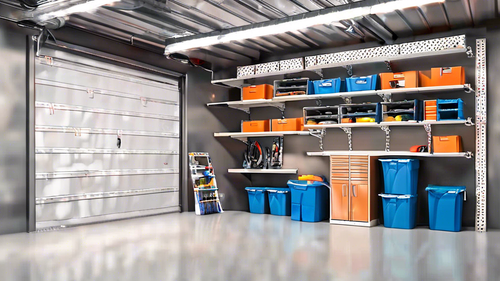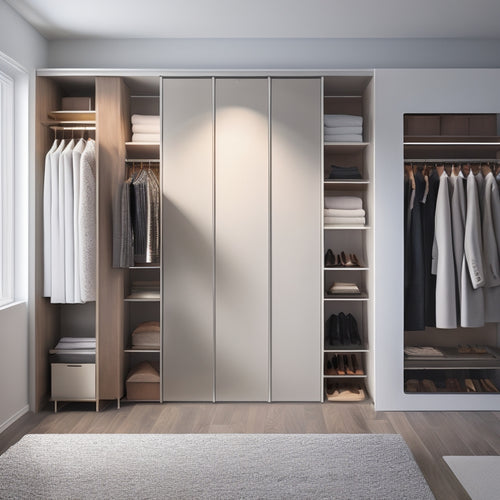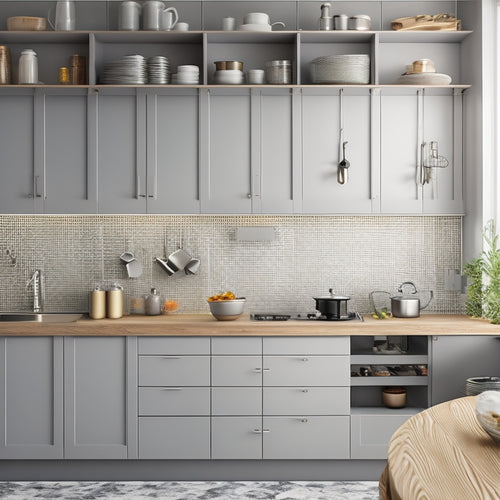
7 Simple Ways to Optimize Your Kitchen Cabinets
Share
You're ready to transform your kitchen cabinets into a haven of organization and efficiency! Start by clearing out unnecessary items and categorizing the rest into groups. Assign a home for each group, maximizing vertical storage spaces with shelves, hooks, and pegboards. Implement a labeling system to keep similar items together, and utilize carousel storage solutions in corner cabinets. Effective drawer dividers will keep utensils and cookware organized, and storing heavy items at the bottom will guarantee safety and stability. With these simple tweaks, you'll be cooking up a storm in no time - and there's even more to discover to take your kitchen to the next level!
Key Takeaways
• Clear out unnecessary items and categorize remaining items into groups to visualize your ideal kitchen cabinet setup.
• Assign specific spots for each group, grouping similar items together, and color-code them for easy identification.
• Maximize vertical storage spaces by installing shelves, hooks, and pegboards, and utilize door organizers for additional storage.
• Implement a labeling system, assigning designated homes for items, color-coding organizational bins, and using magnetic labels for containers.
• Arrange items based on frequency of use, implementing a systematic storage system to streamline meal preparation and cooking processes.
Clear Everything Out First
As you begin on the journey of optimizing your kitchen cabinets, start by clearing out every single item, from dusty cookbooks to mismatched dinner plates, to get a true sense of the space you're working with. This is an essential step, as it allows you to see what you have, what you need, and what you can get rid of.
Purge unnecessary items that are taking up valuable real estate, and consider donating or recycling them. Next, categorize items into groups, such as baking supplies, cooking utensils, and dinnerware. This will help you visualize how you want to organize your cabinets and drawers.
Take note of the items you use frequently and those that are relegated to the back of the shelf. By doing so, you'll be able to create a system that makes sense for your cooking style and habits. With a blank slate, you can now visualize your ideal kitchen cabinet layout and start making deliberate decisions about what stays and what goes.
Assign a Home for Items
With your kitchen cabinets now stripped bare and your items categorized, you're ready to designate a specific spot for each group, ensuring that frequently used utensils, cookbooks, and dinnerware are easily accessible and conveniently located. This is where the magic of organization happens.
To make the most of your cabinet space, group similar items together, like all your baking supplies or cooking utensils. Take it a step further by color coding your groups, so all your red cookbooks are together, and your blue-rimmed plates are stacked neatly. This visual system will make it effortless to find what you need in a flash.
For added efficiency, utilize magnetic strips to hang utensils like knives, spice jars, or even your favorite coffee mugs. This won't only free up shelf space but also add a sleek, modern touch to your cabinets.
Use Vertical Storage Spaces
Maximize your kitchen's vertical real estate by installing shelves, hooks, or pegboards that stretch from floor to ceiling, effectively doubling your storage capacity and keeping frequently used items within easy reach. This strategic move will create a sense of airiness and openness, making your kitchen feel more spacious.
You can hang hooks under shelves to store items like pots, pans, or utensils, freeing up valuable cabinet space. Install door organizers with stackable bins to store spices, oils, or other condiments, keeping them organized and visible. This thoughtful design will also reduce clutter and make meal prep a breeze.
Implement a Labeling System
By assigning a designated home to each item through a thoughtful labeling system, you'll be able to pinpoint the exact location of your kitchen essentials in a split second. This means no more rummaging through cluttered shelves or wasting precious time searching for that one specific spice. A well-designed labeling system is the key to a harmonious kitchen workflow.
Here are three ways to take your labeling game to the next level:
-
Color code your organizational bins to create a visually appealing and easy-to-navigate system. This is especially useful for categorizing similar items, such as baking supplies or cooking utensils.
-
Use magnetic labels on your container storage to add an extra layer of flexibility. This way, you can easily move labels around as your storage needs change.
-
Designate a 'launching pad' for frequently used items, such as oils or spices, to keep them within easy reach. This will save you time and effort in the long run.
Maximize Corner Cabinet Space
As you stand in front of your kitchen, you've probably thought about how to make the most of those pesky corner cabinets.
You're about to reveal the secret to turning these often-wasted spaces into valuable storage areas.
Carousel Storage Solution
You can effortlessly access items tucked away in corner cabinets with a carousel storage solution that revolves to bring hidden contents into view. This ingenious system guarantees that every inch of your corner cabinet is utilized, making it easy to find what you need quickly. No more digging through cluttered shelves or straining to reach items at the back of the cabinet.
Here are three benefits you'll love about carousel storage solutions:
-
Easy access: With a simple turn, you can bring items from the back of the cabinet to the front, saving you time and effort.
-
Increased storage: By maximizing the often-wasted space in corner cabinets, you can store more items, keeping your kitchen organized and clutter-free.
-
Customization: You can choose from various carousel designs, including corner carousels, under-cabinet options, and even add pull-out shelves and hanging hooks to suit your specific needs.
Adjustable Shelving System
Customizing your corner cabinet with an adaptable shelving system lets you create a tailored space that accommodates items of varying sizes, ensuring every nook is utilized. This innovative solution maximizes the often-wasted space in corner cabinets, providing a functional design that streamlines your kitchen workflow.
With adaptable shelves, you can personalize the storage to fit your specific needs, storing everything from cookbooks to kitchen gadgets.
The adaptable shelving system allows you to reconfigure the layout as your needs change, providing personalized organization that adapts to your evolving kitchen demands. Imagine being able to effortlessly access your favorite cookware or spices, without having to dig through cluttered shelves.
This system empowers you to take control of your kitchen's storage, creating a seamless and efficient cooking experience. By incorporating an adaptable shelving system into your corner cabinet, you'll unblock a newfound sense of power and precision in your kitchen, making meal prep a breeze.
Utilize Drawer Dividers Effectively
As you design your kitchen cabinets, you're likely thinking about how to make the most of your drawer space.
By incorporating drawer dividers, you'll be able to separate utensils, cookware, and other essentials into neat, accessible categories.
Organize Utensil Storage
Divided into tailored compartments, your kitchen drawers can finally tame the tangled mess of utensils, freeing up valuable space and streamlining meal prep. By incorporating drawer organizers and utensil caddies, you'll be able to allocate a specific spot for each utensil, making them easily accessible when you need them. This thoughtful organization will also reduce clutter and make cleaning a breeze.
Here are three ways to take your utensil storage to the next level:
-
Designate a home for each utensil: Assign a specific compartment or slot for each utensil, ensuring everything has its own designated space.
-
Utilize vertical space: Install hanging racks or wall hooks to store less frequently used items, keeping them out of the way but still within reach.
-
Keep frequently used items front and center: Place your most-used utensils in easy-to-reach locations, saving you time and effort during meal prep.
Maximize Drawer Space
By strategically placing drawer dividers, you can carve out precise zones within your kitchen drawers, ensuring that every utensil and gadget has a snug, assigned spot.
This thoughtful approach to drawer organization enables you to make the most of your available space, creating a sense of calm and control in the heart of your kitchen.
To take your drawer organization to the next level, consider custom drawer inserts that can be tailored to fit your unique needs and preferences. These smart solutions can be designed to accommodate everything from cooking utensils to dinnerware, keeping each item neatly contained and easily accessible.
Store Heavy Items at Bottom
Store Heavy Items at Bottom
Placing heavy items, like pots and pans, at the bottom of your kitchen cabinets assures they're easily accessible while maintaining the overall weight distribution of the cabinet stable. This simple trick prevents your cabinets from becoming top-heavy, reducing the risk of them tipping over or collapsing under the weight.
By storing heavy items at the bottom, you'll also:
-
Save energy: No more straining to reach heavy pots and pans on high shelves.
-
Reduce clutter: Heavy items at the bottom create a sense of openness and flow in your kitchen.
-
Increase safety: Prevent accidents by keeping heavy objects out of reach of children and pets.
When organizing your pots and pans, utilize pantry shelves to maximize storage space. This will help keep your kitchen cabinets tidy and make cooking a breeze. By storing heavy items at the bottom, you'll create a more efficient, safe, and stylish kitchen that exudes power and sophistication.
Frequently Asked Questions
How Do I Measure My Kitchen Cabinets Accurately?
"Like a Renaissance cartographer mapping uncharted lands, you'll chart your kitchen's topography by measuring cabinet layouts with precision, ensuring a seamless installation process that unfolds like a well-oiled machine, every inch accounted for."
Can I DIY My Own Cabinet Organizers and Dividers?
You can totally tackle DIY projects, crafting custom solutions that fit your unique style! With a few tools and some creativity, you'll create cabinet organizers and dividers that maximize space and elevate your kitchen's functionality.
What Is the Best Material for Cabinet Shelves?
When choosing cabinet shelves, you'll weigh wood's warm aesthetic against metal's durability, and glass's sophistication versus plastic's affordability. Consider your style, budget, and functional needs to select the best material that elevates your kitchen's overall look and feel.
How Often Should I Clean and Maintain My Kitchen Cabinets?
"You're probably guilty of neglecting those kitchen cabinets, but it's time to get real - clean them every 1-2 weeks, and maintain with storage solutions and organization hacks to keep your space sleek and powerful."
Are Soft-Close Cabinet Hinges Worth the Extra Cost?
You're weighing the cost of soft-close cabinet hinges, and it's worth it - they elevate your cabinet hardware with smooth functionality, making installation a breeze and ensuring efficiency in your kitchen workflow.
Related Posts
-

Organize Your Garage Overhead Storage: A Quick Guide
As a homeowner, you know that keeping your garage organized can be a challenge. If your garage is anything like m...
-

Declutter Your Closet With Digital Essentials
You're about to transform your closet from a cluttered chaos to a curated sanctuary with the power of digital essenti...
-

What Makes Ideal Kitchen Storage Solutions
In your ideal kitchen, you'll find a harmonious balance of style and functionality, where every item has a designated...


